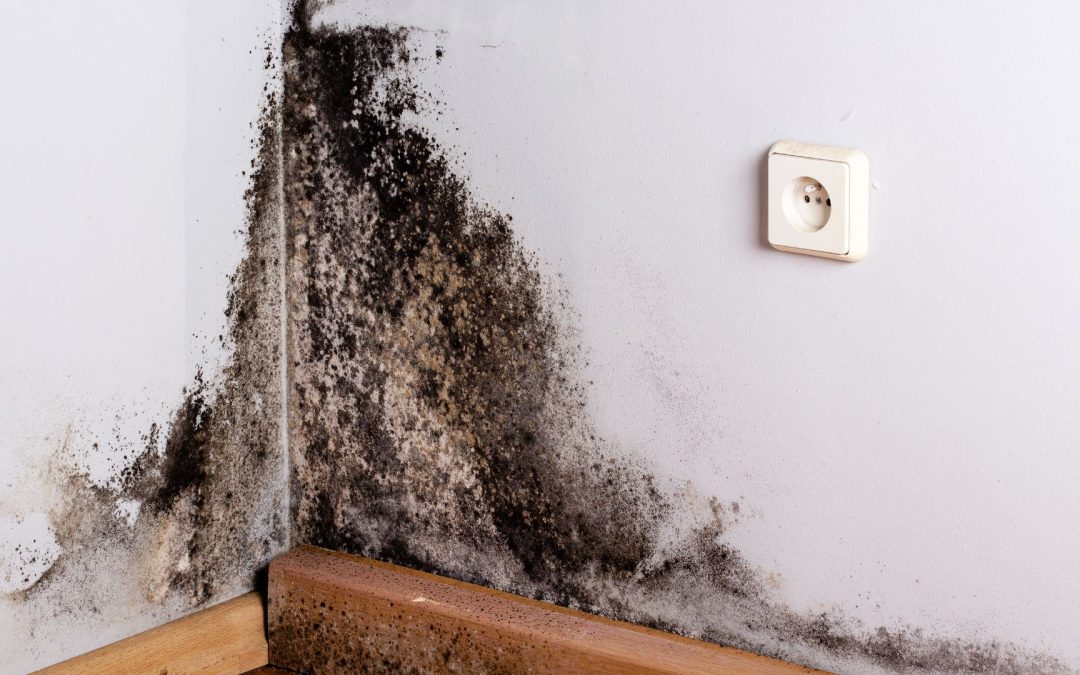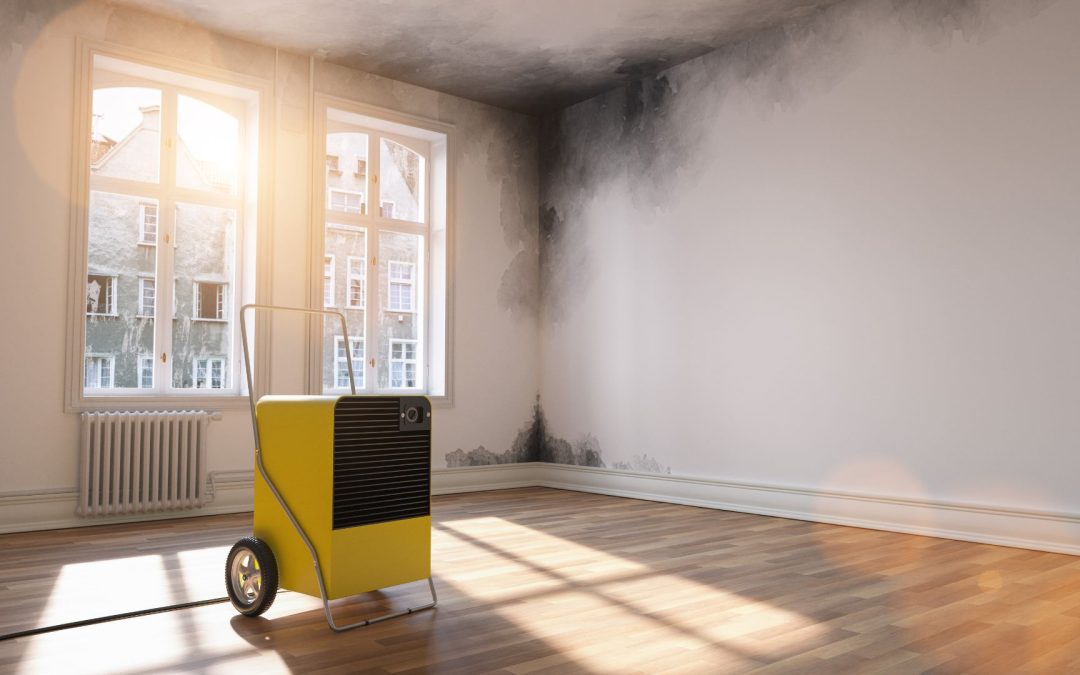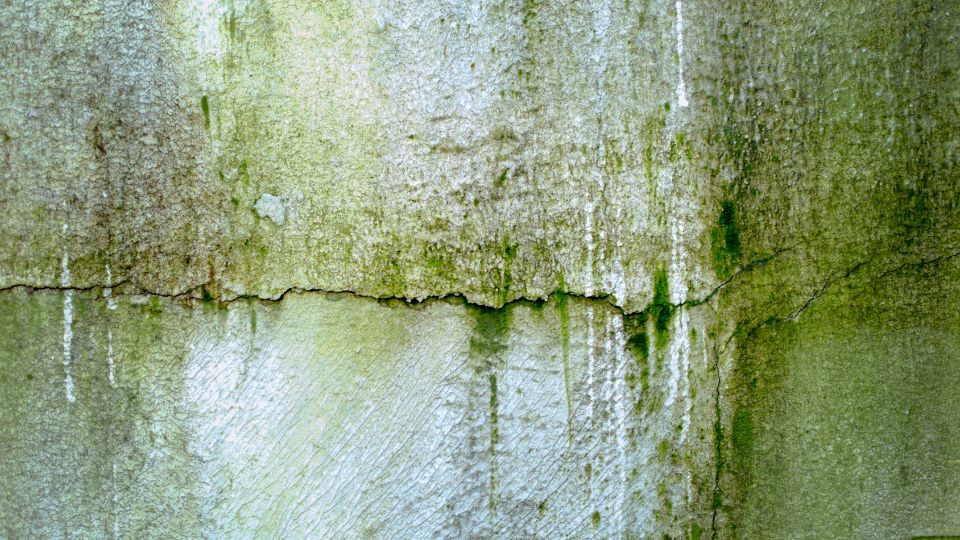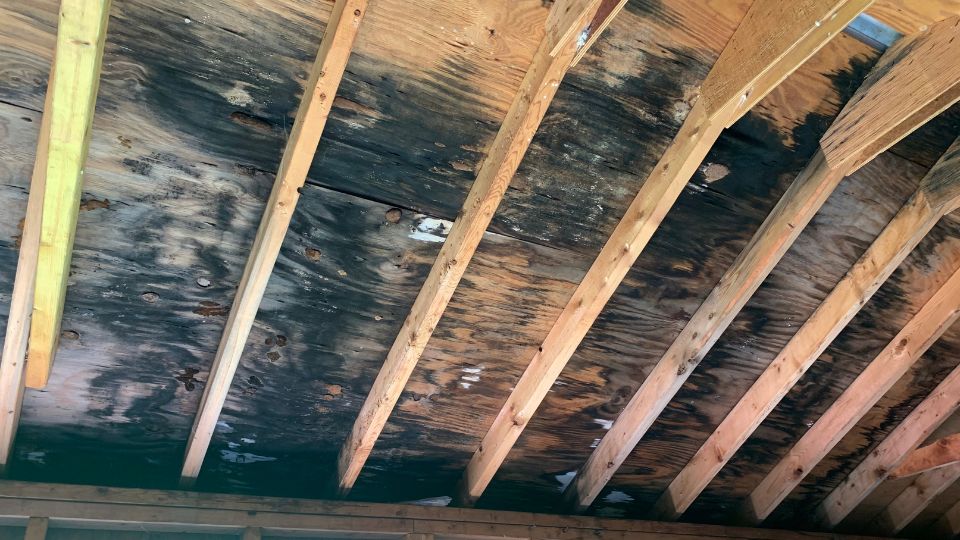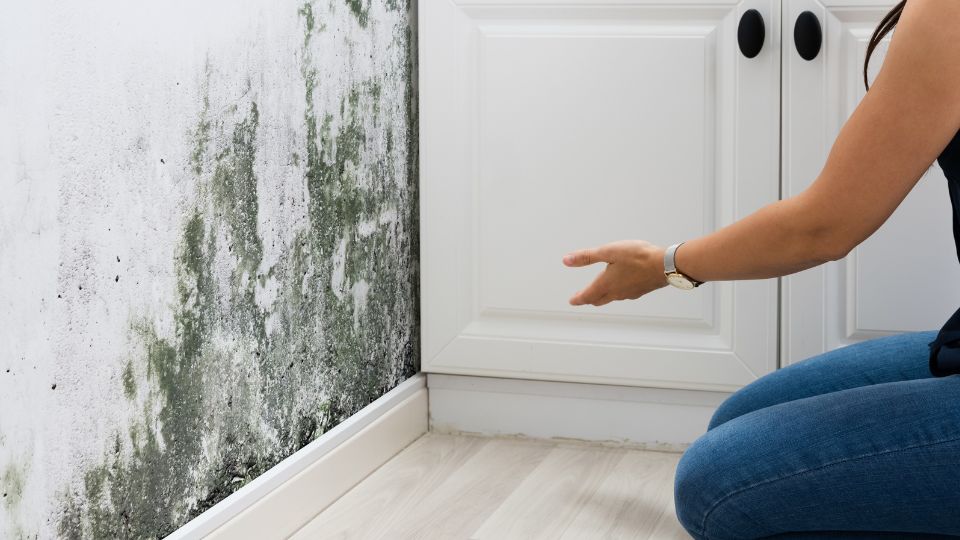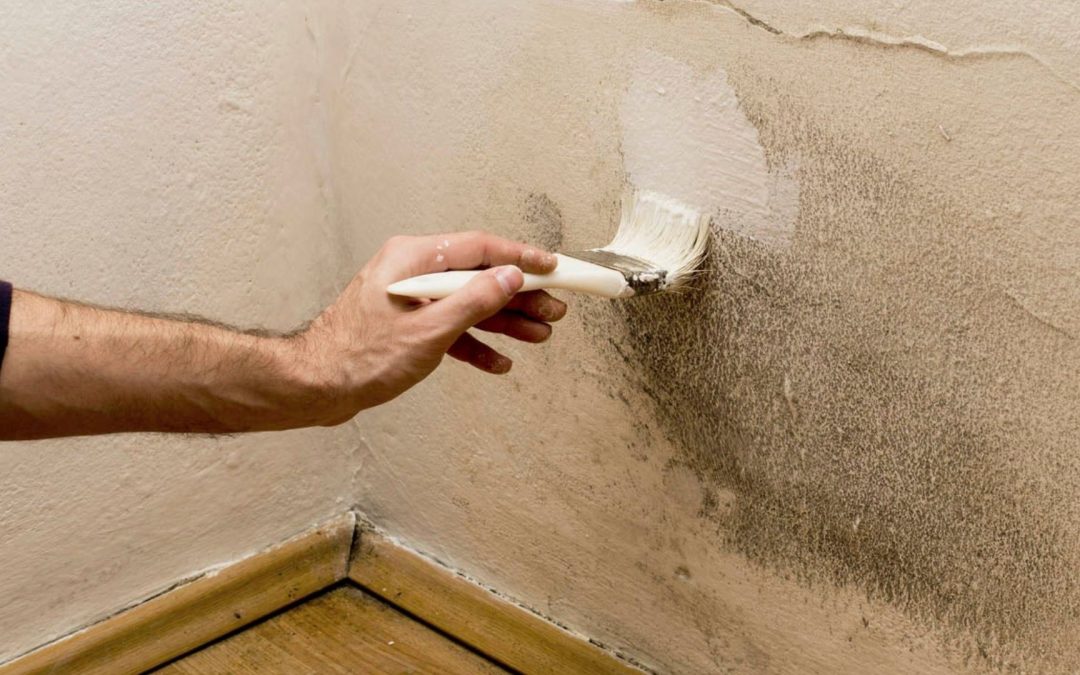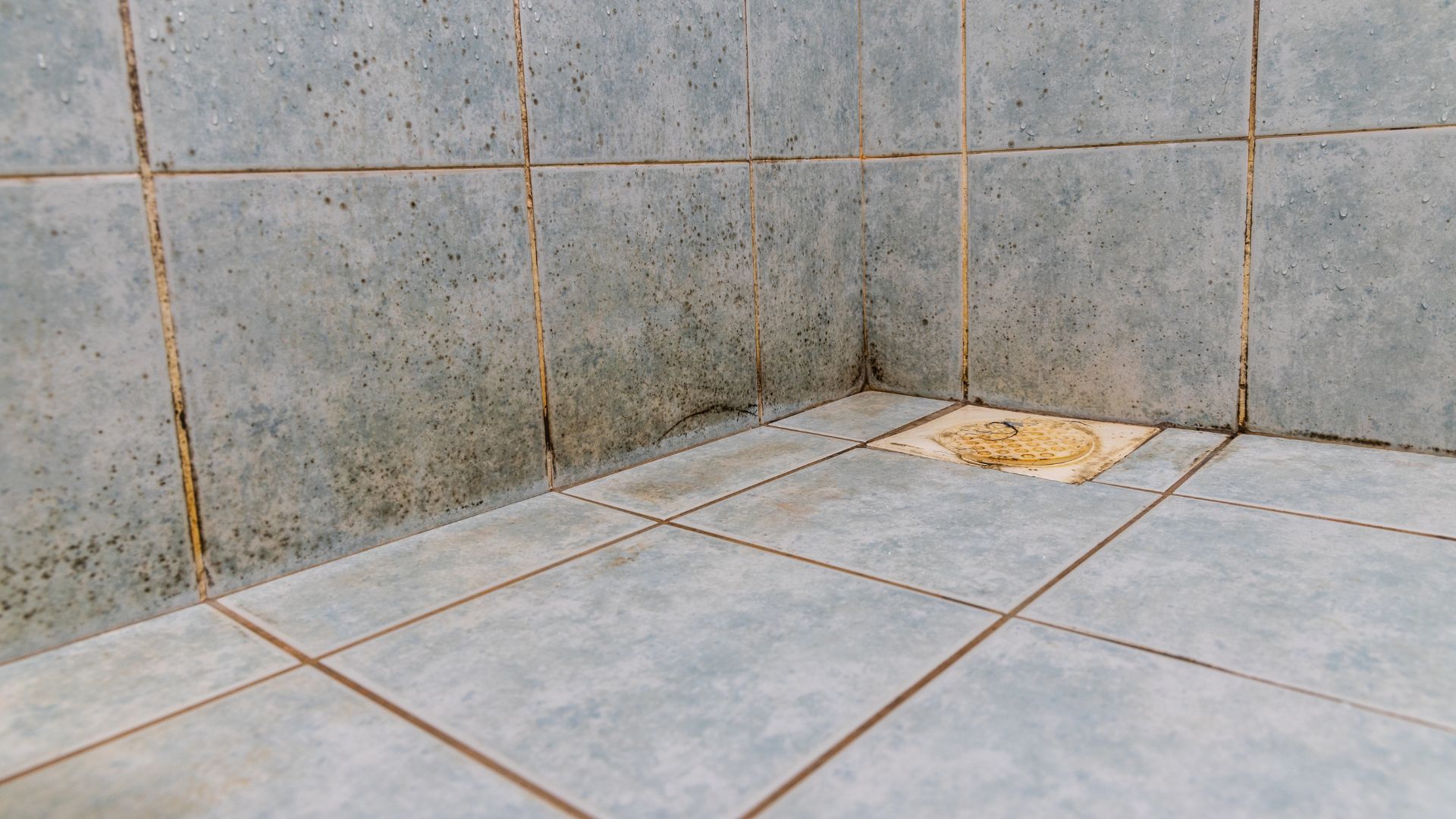
by Mold-B-Gone | Oct 12, 2022 | Black Mold
Mold is found in many households in the U.S., and while it can be unsightly, it’s usually not a cause for alarm. It is a fungus commonly found in damp areas and can cause serious health problems if left unchecked. The primary difference between mold and fungus is that mold is green or black, while fungus can be any color.
Also, a fungus is composed of microscopic spores, while a mold is composed of filaments. The fungus typically grows on food or soil, while mold usually grows on damp surfaces.
Read more: Mold vs. Fungus: Their Similarities and Differences
Black mold can be black, green, or brown. It’s often found in damp areas, such as bathrooms, kitchens, and basements. If left unchecked, black mold can cause serious health problems.
Read on to learn about black mold and its dangers.
What Is Black Mold?
Black mold, known as Stachybotrys chartarum, is a mold that thrives in damp, dark environments. It’s often found in homes and buildings damaged by water or flooding. Black mold can cause serious health problems, including respiratory illness, neurological damage, and even death.
Signs of a Black Mold Infestation in Your Home
1) Visible Mold Growth
You can find black mold anywhere in your home where there is moisture, such as in damp basements, showers, or leaky pipes. The mold may appear as black specks, streaks, or blotches and can quickly spread if not removed.
2) Musty Odors
Black mold emits a gas called mycotoxin, which smells musty. If you notice this musty smell, it’s essential to investigate further to see if mold is present.
3) Respiratory Problems
When inhaled, black mold can cause several respiratory problems, including:
- Asthma
- Allergies
- Bronchitis
- Inflammation of the lungs
- In severe cases, black mold inhalation can even lead to death.
How To Prevent or Get Rid of Black Mold: Tips
1) Ventilation
Adequate ventilation is key to preventing the growth of mold. Be sure to ventilate any areas in your home prone to moisture, such as the kitchen and bathroom. Use exhaust fans or open windows to help circulate air and keep these areas dry.
2) Humidity
Mold thrives in humid environments, so it’s essential to keep the humidity level in your home low. Use a dehumidifier to help remove excess moisture from the air.
3) Water Damage
One of the most common ways mold enters the home is through water damage. If your home has experienced flooding or a leak, dry the area thoroughly and repair any damage to prevent mold from growing.
4) Cleaning
A good cleaning routine is essential for preventing the growth of mold. Be sure to clean any areas of your home prone to moisture, such as the kitchen and bathroom. Use a mild detergent and water to clean these areas
5) Mold-resistant products
Many products, like paints, caulk, sealants, etc., have mold-resistant features. You can use these products in areas more prone to moisture and susceptible to black mold growth.
While black mold may not be as toxic as other types of mold, it can still pose serious health risks. Exposure to black mold can cause several respiratory problems, including coughing, wheezing, and difficulty breathing.
You may wonder if cleaning or removing black mold is safe. It is better to call experts for mold removal in Atlanta, like Mold B Gone. We use the best EPA-registered products, and our approach is always efficient and effective.

by Mold-B-Gone | Oct 4, 2022 | Mold and Infants, Mold Inspection
23-year-old Juliana, from New South Wales, Australia, had to be evicted from her home after authorities condemned it. The cause? A rampant mold infestation caused by a year of damp, wet weather.
“It’s really disgusting,” she told to NCA NewsWire. “It started out just in the corners of our bedrooms and living area, but at this point it’s taken over most of the walls and roofing spaces. Even after multiple attempts to remove it, it keeps growing back thicker and in new spots.”
Juliana and her two roommates were all affected. The mold spread to their personal belongings and may be the cause of a mysterious illness.
“Both of my roommates have been sick for the past six months with no explanation – a constant cough and runny nose,” Juliana said. “We’re pretty certain this is from the mold growing in their bedrooms.”
Even though they tried to deal with it themselves, the constant rain and damp weather created the perfect conditions for the mold to re-emerge. Their landlord stepped in to try and deal with the problem, but it was to no avail.
Ultimately, the three housemates had to leave the home because it was condemned.
She’s not the only one that has been dealing with mold. People living in places like Georgia, with humid climates and damp winters, are at increased risk of mold in their homes.
What Are The Signs of Mold In My Home?
Mold development can be concealed. Mold may develop behind walls or above ceiling tiles. Therefore, inspecting for mold in any wet area is critical, especially if water damage has occurred.
Begin by performing a visual survey of your home. Look for stains or discoloration on floors, walls, window panes, ceiling tiles, textiles, and carpets that indicate mold or excessive moisture. Examine the area for evident leaks, dampness, floods, or a musty stench. If you detect anything strange, take immediate action!
How Can I Remove Mold From My Home?
Do not attempt to remove mold yourself. Although mold seems simple to kill, it is not simple to eliminate. One mold spore can spawn a huge infestation quickly. Many landlords and homeowners are tempted to remove mold by themselves to save on costs. However, the risk is much greater than the initial cost of mold remediation and is seldom done correctly. If the mold gets out of control, you might need to have your home demolished like Juliana’s home was.
We recommend hiring the most trusted professional in your area. If you’re in or around Atlanta, Mold-B-Gone is an excellent choice.
Mold-B-Gone: Atlanta’s Mold Remediation Experts
Our highly skilled team of certified mold removal experts specializes in whole-house cleaning. We have done mold removal services for thousands of homes and companies in Atlanta over the years and never failed a test on any house or commercial structure. Since we opened our doors, we have had a 100% rating for our mold cleaning service in Atlanta. Give us a call at (470) 545-4467 today!

by Mold-B-Gone | Sep 20, 2022 | Green Mold, Mold Facts
Mold is a fungus that can grow almost anywhere there is moisture and organic material. In some cases, it can be dangerous to your health. According to EPA, mold can cause a variety of respiratory problems, as well as skin irritation. Taking action immediately is essential if you think you have mold in a home.
The first step is to identify the type of mold you’re dealing with. Many of us do not know the difference between mold and fungus. Mold is a fungus that can grow on wet surfaces. It’s often green, black, or white. On the other hand, the fungus is a plant-like organism that feeds on organic matter.
Read more: Mold vs. Fungus: Their Similarities and Differences.
One of the dangerous forms of mold is green in color. Green mold is also known by its scientific name, Stachybotrys chartarum. This mold is often found in damp or water-damaged areas, such as basements, crawl spaces, and attics. Read on to understand green mold, its dangers, and how to get rid of it.
What Is a Green Mold?
Green mold is fungi that can grow indoors and outdoors. It thrives in moist, warm environments and can often be found in basements, bathrooms, kitchens, laundry rooms, and on or around building materials that have been water damaged. Green mold can also be found in food that has gone bad.
While green mold is not necessarily more dangerous than other types of mold, it can cause health problems for people with allergies or respiratory conditions. Green mold can also cause damage to the material it is growing on.
For example, wooden beams or drywall covered in the green mold may need to be replaced.
If you think you have green mold in your home or business, it is essential to have it removed by a professional as soon as possible.
Tips and Tricks By Professionals to Remove Green Mold
1. Identify the Source of Green Mold
It is probably the most critical step as you need to know where the mold is coming from to remove it properly. Some familiar places for mold growth are leaky pipes, windows, or roofs; condensation on cooling coils of air conditioners; and damp basements or crawlspaces. You should also check for any water damage, as this can be a breeding ground for mold spores.
2. Isolate Affected Areas
After identifying and locating the source of green mold, isolate all affected areas so that the spores do not spread. You can do it by sealing off the rooms with plastic sheeting and using a HEPA filter. Experts wear proper protective gear such as gloves, goggles, and respirators while handling moldy materials.
3. Ventilate Your Home
Open your windows and allow fresh air to circulate throughout your home to help dry out any affected areas. The more quickly you can dry out these areas, the less likely new mold will grow.
4. Use a Commercial Mold Removal Product or Solution
These contain chemicals that can kill mold and mildew.
5. Remove All Material That May Have Been Affected by Mold
Any material in your home that has been affected by green mold (e.g., drywall, insulation, carpeting) needs to be removed and replaced. This is because cleaning and disinfecting these materials will be challenging, and they may continue to harbor mold spores even after you’ve removed the visible mold growth.
Contact Mold-B-Gone for the mold removal company in Atlanta. We are experts in mold remediation and will get rid of your green mold problem quickly and efficiently.

by Mold-B-Gone | Sep 6, 2022 | Mold Facts, Mold in Wood
Mold spores in the air are inevitable, and so is the mold growing on your wood furniture. No matter how often you clean or how well you ventilate your home, there will always be a few spores that slip through and take root in the dampest corners of your house.
Read more: 7 Places Mold Hides In Your Home!
Wooden furniture is especially susceptible to mold growth because they are often kept in humid environments. The good news is that mold on wood furniture is relatively easy to remove, as long as you take the necessary precautions.
Here are a few tips and tricks for removing mold from wood furniture:
1. Identify the Source of Moisture
There are different sources of moisture that can cause mold to grow on wood. These include:
- leaks in the roof or walls
- high humidity levels
- flooding
- damp basements or crawl spaces
If you can identify and fix the source of moisture, this will help to prevent mold from growing back.
2. Use a Dehumidifier
A dehumidifier is a way to remove mold from unfinished wood and cabinets. If the humidity in your home is too high, it can create the perfect environment for mold to grow. Using a dehumidifier can lower the humidity levels and make your home less hospitable for mold.
It is a machine that helps to remove water from the air. Dehumidifiers can be used in many settings, such as during construction, flooding, or high humidity levels.
There are two types of dehumidifiers: desiccant and refrigerant.
- Desiccant dehumidifiers work by absorbing moisture from the air.
- Refrigerant dehumidifiers work by cooling the air and condensing the water vapor.
3. Open Windows and Doors To Allow for Air Circulation
Mold growth is often the result of stagnant, humid air. Allowing fresh air to circulate throughout your home is essential for preventing mold growth and removing existing mold. If possible, open windows and doors to create a cross breeze and improve airflow. You can use fans to help circulate the air in your home.
4. Vacuum the Furniture
Vacuuming is the first step in mold remediation. Use a HEPA filter to avoid spreading spores while you vacuum. If you don’t have a HEPA filter, seal the bag after each use to prevent spores from escaping.
Use a brush attachment to vacuum moldy areas. If the mold has penetrated deep into the wood, you may need to sand the affected area before vacuuming.
After vacuuming, use a damp cloth to wipe down the furniture. This will remove any mold spores that are left behind.
5. Mix Vinegar and Water for Cleaning
The best cleaning solution for white mold on wood is a mix of vinegar and water. Use equal parts vinegar and water; if you’re using distilled white vinegar, use one part vinegar to four parts water.
This natural solution is safe for people and pets and effectively cleans mold off wood surfaces. Apply the mixture to the affected area with a sponge or cloth and scrub until the mold is gone.
6. Sand the Wood
Sandpaper is a great way to remove mold from wood. Be sure to sand in the grain direction to avoid damaging the wood. If you are searching for a mold removal specialist in Atlanta, contact Mold-B-Gone. Our highly trained professionals are experts in mold removal and will work diligently to rid your home of mold.

by Mold-B-Gone | Aug 23, 2022 | Killing Mold, Mold Facts
Amie Skilton from Australia was 37 years old when she moved into an apartment with her now-husband. She was perfectly healthy: she traveled around the country giving keynote speeches, did “fun runs”, and worked as a naturopath and nutritionist.
Then she started to get sick. She noticed allergy symptoms, she gained over 20 pounds, and she started getting chronic fatigue. Amie even started to forget her own name.
Shaken and puzzled, her now-husband took her to the doctor’s office, where they performed a battery of tests. All the tests came back fine, stunning the doctors.
She was referred to a neurologist who later diagnosed her with Type III Alzheimer’s. Type III Alzheimer’s disease is also known as inhalational Alzheimer’s and is caused by airborne toxins.
Amie had a mold expert check her home and found that the underside of the carpet was lined with black mold. This mold grew after a pipe leaked and soaked the carpet, and Amie didn’t know about it until she was already sick. Luckily, after moving out of the apartment, her brain function returned to normal. But who knows what could have happened to Amie if it had gone unchecked?
Today, Amie is a qualified mold testing technician in her native Australia who educates others about the dangers of mold.
The Dangers of Black Mold
Toxic black mold, or Stachybotrys chartarum, grows in wet conditions under the carpet, drywall, and flooring. They produce highly poisonous spores that can cause respiratory illness and fatigue. But not everyone is affected equally.
In Amie’s case, her genetic predisposition caused a severe reaction to mold spores. Just as some people are intolerant to lactose or gluten, some people are strongly affected by toxic mold spores. Most people won’t know until it’s too late.
What To Do About Black Mold In The Home
An ounce of prevention is worth a pound of cure. The best way to deal with black mold in the home is to prevent it from growing in the first place. Water damage is usually the cause, and it’s best to call a specialist immediately if a leak is ever found.
Another cause of mold growth is a high level of humidity in the home. Ensure adequate ventilation to prevent mold growth. Keep humidity levels between 30% and 50% in the home, and check your humidity levels with a meter. A single room might be more humid than others; if that’s the case, a dehumidifier can help. If you’re having persistent issues with humidity in your home, call an HVAC specialist.
The truth about black mold is that once it’s found in a home, it needs to be removed by a professional. Professional mold remediation experts have the tools necessary to remove black mold and prevent it from causing further health issues. Otherwise, it’s best to move to a clean home if you find black mold.
Mold Remediation in Atlanta
25% of the human population has a genetic predisposition to mold-related illness, and most people don’t take the chance: keep your family safe with mold remediation in Atlanta by Mold-B-Gone.
Mold-B-Gone is the premier mold remediation company in Atlanta, specializing in whole-house mold removal. We clear mold caused by water damage and humidity. 100% of our client’s homes have passed a mold inspection in Atlanta after working with us. Best of all, we offer a 5-year written guarantee on all mold removal services.
Speak to a mold removal expert today; call 470-545-4467 and enjoy peace of mind knowing your family is safe.
Read Amie Skilton’s full New York Post story here.

by Mold-B-Gone | Aug 2, 2022 | Mold Facts
Mold is a fungus that can grow almost anywhere there is moisture and organic material. It thrives in humid environments and can cause health problems in people exposed to it.
CDC reports that mold exposure can cause various respiratory problems, including coughing, wheezing, and difficulty breathing. It will cause skin irritation and allergic reactions.
Mold spores are tiny and can be carried by the wind or water so that they can spread quickly. Many believe mold dies when it dries out, but that is not the case. Mold can survive in both dry and wet conditions.
Read on to understand mold and how to prevent it from growing in your home.
How Does Mold Grow in Homes?
Mold typically enters homes through open doors, windows, or vents. Once inside, it can quickly begin to grow and spread. Mold loves damp, dark, and humid environments, so bathrooms, basements, and laundry rooms are often ideal spots for mold growth. Leaky pipes or roofs can also create the perfect conditions for mold to thrive.
When the indoor humidity levels are high, mold can grow on various surfaces, including wood, carpet, paper, and food. Mold can also grow on dust, lint, or fabric fibers.
What Happens When Mold Spores Lack Moisture?
Mold spores need moisture to grow and multiply, but they can remain dormant for years without it. When mold spores land on a moist surface, they begin to reproduce. The new mold colony then produces more spores carried away by the wind or water droplets to start new colonies elsewhere.
So what happens when mold spores are deprived of moisture? They don’t die, but they do become inactive. If the conditions that caused the mold growth in the first place are no longer present, the spores will remain dormant until they once again come into contact with water or high humidity.
Some mold spores are more resistant to drying out than others, which is why mold can often return after removal. It’s essential to address the underlying moisture problem to prevent mold from returning.
Read more: 10 Facts About Mold People Did Not Know.
Is Completely Dried Mold Safe?
Once the mold is completely dried, they become light in weight and fragile. They can spread through the air very quickly. It can easily contaminate other areas and items.
For example, black mold is a type of mold that can release toxins called mycotoxins. These toxins can cause serious health problems in humans, especially in young children and the elderly.
Expert Methods for Mold Removal
Insulate the area: One of the most important things you can do to prevent mold is to insulate your home. It will help to keep moisture out and prevent condensation from building up.
Use a dehumidifier: By keeping the air in your home dry, you can also prevent mold from growing. Dehumidifiers help to remove moisture from the air, which can then be drained away.
Keep the area clean: mold loves to grow in dark, damp, and cluttered areas. So by keeping a home clean and free of clutter, you can help to prevent mold from growing.
Contact Mold-B-Gone for expert mold removal service in Atlanta. “We are experts in mold remediation and will ensure your home is mold-free.
For more information on mold, read our blog:- 7 Types of Mold You Might Encounter in Your House.

by Mold-B-Gone | Jul 20, 2022 | Mold Facts
Mold and Mycotoxins can have a severe impact on your health. It can cause respiratory, skin irritation, and other serious health problems.
Mold can be a pesky issue. It often pops up where it’s hard to see and even harder to get rid of. So, what happens when you find black mold on your walls or ceilings? Can you paint over it and make the problem disappear? What happens when you cover mold with paint to kill it?
This blog post will explore the answer to that question and more! We’ll discuss what mold is, why you should avoid painting over it if possible, and some tips for getting rid of mold once and for all.
What Problems Can Occur If You Paint Over Mold?
Mold is a fungus found in damp, humid environments. It can grow on almost any surface, including wood, paper, cloth, and concrete. When mold spores touch a wet or moist surface, they grow and multiply.
Mold reproduces by spreading spores into the air. The spores are invisible to the naked eye and can travel long distances. When they land on a surface, they start to grow and form new mold colonies.
If you paint directly over mold, it can result in problems like:
- The paint does not adhere properly to the surface
- The mold continues to grow beneath the paint
- Health problems from exposure to mold spores
- Bubbling and peeling of the paint
So, as you can understand, it’s not a good idea to try and cover up mold with paint. But what can you do to get rid of it? It is best to call a mold remediation specialist to take care of the problem for you. They have the knowledge and experience to safely remove mold from your home before you paint the walls and ceilings.
Read more: How To Detect Mold Behind Walls
Steps Followed by Experts to Remove Mold
Here are some steps to eliminate mold before painting over it:
- Start by identifying the source of moisture
- Scrape the mold off
- Apply a mold-resistant primer
- Paint with mold-resistant paint
Read more: How to Remove Mold from Wood: Expert Tips and Tricks
If you follow these steps, you can remove the mold before painting over it effectively. However, if the source of moisture is not eliminated, the mold will continue to grow and eventually cause the paint to peel.
Is mold a concern during renovations? It’s best to hire a professional. Mold remediation services involve identifying the source of moisture, removing the mold, and repairing any water damage. It will ensure that the mold doesn’t come back and that your paint job will last.
Mold-Be-Gone offers the best mold inspection in Atlanta. Our company is certified, licensed, and insured. We provide services for all residential customers, including crawlspace encapsulation, IAQ testing, duct cleaning, eviction clean-outs, and whole-house & room sanitizing. Our final goal is to rid your home of mold and mildew. Get in touch with us to start the process.

by Mold-B-Gone | Jul 6, 2022 | Bathroom Mold
Mold can be a pesky problem in the bathroom. It often pops up in damp and humid environments and can be challenging to get rid of. According to the EPA (Environmental Protection Agency), mold can cause various health problems, including respiratory issues, headaches, and skin irritations.
If you’re struggling with mold in the bathroom, don’t worry – we’ve covered you. This blog post will discuss four tips for removing bathroom mold from your home. We’ll also provide some helpful resources to help you prevent mold outbreaks.
1. Identify the Source of the Mold and Fix It
Mold growth happens due to condensation, water leaks, or high humidity. If you find mold in your bathroom, look for the source of moisture causing it and fix it. Once the source is fixed, the mold will stop growing.
For example, professional mold removal companies say leaks often cause mold in bathrooms in the shower or around the toilet.
If you leak, fix it and dry the area thoroughly to prevent mold from growing back.
Read this article to understand why is mold growing in my toilet. It will give the right reasons and solutions to deal with the problem.
2. Dry Out the Area As Quickly As Possible
Use a dehumidifier or open the bathroom window to help circulate air and dry out the area. If you can, find the source of the moisture and fix it. If your bathroom is prone to condensation, make sure to use an exhaust fan during showers and baths, and keep the door open afterward to allow any lingering moisture to dissipate.
3. Use a Disinfectant To Kill the Mold Spores
Disinfectants contain chemicals that can kill mold spores. You can purchase these at most hardware stores. Ensure to check the instructions on the label, and take care when using them as some disinfectants can be harmful if misused.
Hiring an expert to remove mold from your bathroom is suitable if the problem is severe. They will have the equipment and experience to eliminate mold safely and effectively.
4. Prevent Future Mold Growth
Black mold is often found in bathroom showers, ceilings, and walls. After you clean or remove the mold, you need to take steps to prevent future mold growth. To do this, you need to:
- Keep your bathroom clean and dry
- Use an exhaust fan or open a window when showering
- Fix any leaks in your bathroom
- Clean up any spills promptly
- Dry off wet areas after use
- Use mold-resistant products
- Monitor your bathroom for mold growth regularly
If you find mold growing in the bathroom, you should clean it immediately. By taking these steps, you can prevent mold growth and keep your bathroom looking and smelling fresh.
For expert mold removal service Atlanta, Mold-Be-Gone is the company to call. We have several years of experience in mold remediation and removal. Our certified professionals will work quickly and efficiently to rid your home or office of mold infestation.

by Mold-B-Gone | Jun 13, 2022 | Mold Facts, Uncategorized
Mold are microscopic fungi that grow with ease in moist and dusty conditions. They are mostly present in bathrooms, under kitchen sinks, in areas where water has leaked into walls or floors and in wet insulated areas. Sometimes mold also grows on window sills. Mold growing on window sills is also as a result of moisture and dust accumulation. This dust and moisture is commonly found between window panes, along wooden window sills and frames. In certain scenarios, one may also find mold in window tracks. Any small crevices around a window can offer an ideal environment for mold growth if dust and humidity are present.
What Causes Mold around Windows?
In some cases, mold on window glass may occur as a result of air trapped in between two window panes. The most notable cause of this is condensation. This usually happens when the relatively warm air inside a room hits the window glass and gets rapidly cooled by the air outside, resulting in condensation. Some of the factors that may cause condensation include:
- Wet and humid weather.
- Inadequate heating.
- Leaking pipes
- Steam deposits caused by bath or shower.
- Wood burners and open fires.
Also see What Helps Mould Spread Through Your Home?
How to Prevent mold on window sills
It can be quite difficult to detect mold in between window panes since it develops in hard to see sections. It’s not surprising to find mold blending in with the color of your windows. This can make it almost impossible to detect it with an untrained eye. Some of the simple solutions to prevent mold growth include:
- Proper ventilation in bathrooms and turning on the extractor fan. This is to ensure that all the steam produced while a shower or bath is running is able to escape. You can also wipe down wet surfaces to aid the process.
- Dehumidifier-This machines come in a variety of sizes and help to get rid of excess moisture in the air.
- Maintaining your home’s constant temperature will help control the condensation levels. This is because when warm air rapidly gets cold then warm again, moisture is produced creating an ideal environment for mold to grow.
- Double glazed windows- creating an insulating layer between the cold outside and the warm inside is an efficient method to curb mold growth. Blocking heat from passing inside to outside and vice versa means that the inner pane is constantly warm, preventing the ideal conditions for mold growth.
After doing your research on how to get rid of mold in windows, it’s recommended that you seek expert advice from professionals with proper protective equipment and sufficient knowledge. This guarantees that during the cleaning process, there’s low chances of the spores circulating throughout your home.
If you have questions regarding Mold removal in Atlanta or you’d like mold removed from your home professionally, feel free to contact Mold Remediation & Removal Atlanta, GA. They’ll ensure your damaged house or property receives the best possible mold treatment.

by Mold-B-Gone | Jun 9, 2022 | Mold Facts, Uncategorized
Did you know that mold the size of a fist can produce thousands of mold spores into the atmosphere? Once the spores are airborne, they can be inhaled by the occupants of a house. What happens next is that an irritation develops in the lining of the throat leading to a mold exposure cough. Not everyone experiences cough due to mold since it does not infect every single occupant of a house. However, infants, children and the elderly are at a much higher risk of being affected. People suffering from respiratory diseases are also in danger of contracting coughing from mold. Extreme exposure of mold has been known to affect even pets.
Other notable symptoms of what breathing in mold can do include:
- Sore throat
- Running nose
- Headaches
- Wheezing
- Shortness of breath
- Sneezing
Other respiratory diseases related to mold such as pneumonia and bronchitis are also accompanied by coughing. However, it is important to seek medical advice from your doctor to determine if mold does make you cough. Once you are tested, the doctor will prescribe antibiotics to deal with the existing underlying infection.
Are There Treatments For Cough Caused By Mold?
Antihistamines may also be prescribed to aid the mucus in drying up. Cough tablets and syrup can help curb consistent coughing especially if you are not getting any sleep because of it. To soothe your cough and prevent further damage to your throat, use cough drops.
Headaches are also heavily associated with coughing, so it’s possible that the doctor would also prescribe some painkillers.
Related: What Is The Link Between Mold and Asthma?
You are highly advised not to buy over the counter drugs especially if you have an existing prescription. Instead, you should seek help from a qualified medical practitioner.
To facilitate your healing process after coughing from mold, you need to permanently remove yourself from the infected areas. Failing to do so means that your condition will deteriorate.
How Do I Prevent Cough From Mold?
It’s important that you carry out a thorough mold removal process in your household and enforce preventive measures to help curb mold related illnesses. To successfully do this, you need to identify the source of moisture on your walls and deal with it. Ensure you remove the contaminated materials then conduct proper cleaning on the affected areas.
Other respiratory diseases related to mold such as pneumonia and bronchitis are also accompanied by coughing. It’s therefore recommended you seek experts that will arrange a home visit. Their qualifications and experience come in handy to help make sure that all mold affected areas receive the best possible treatment. Most of the time, these home visits by mold removal companies are free so no form of payment is required upfront.
If you’ve recently suffered from a mold related illness, ensure you are not involved in the process of mold removal and instead seek help.
Mold Remediation Atlanta
If you have questions about mold remediation in Atlanta or you’d like help removing mold in your home, contact Mold-B-Gone for Mold Remediation & Removal Atlanta. They have a track record of helping so many homes around Atlanta eliminate mold. Try them out today.
